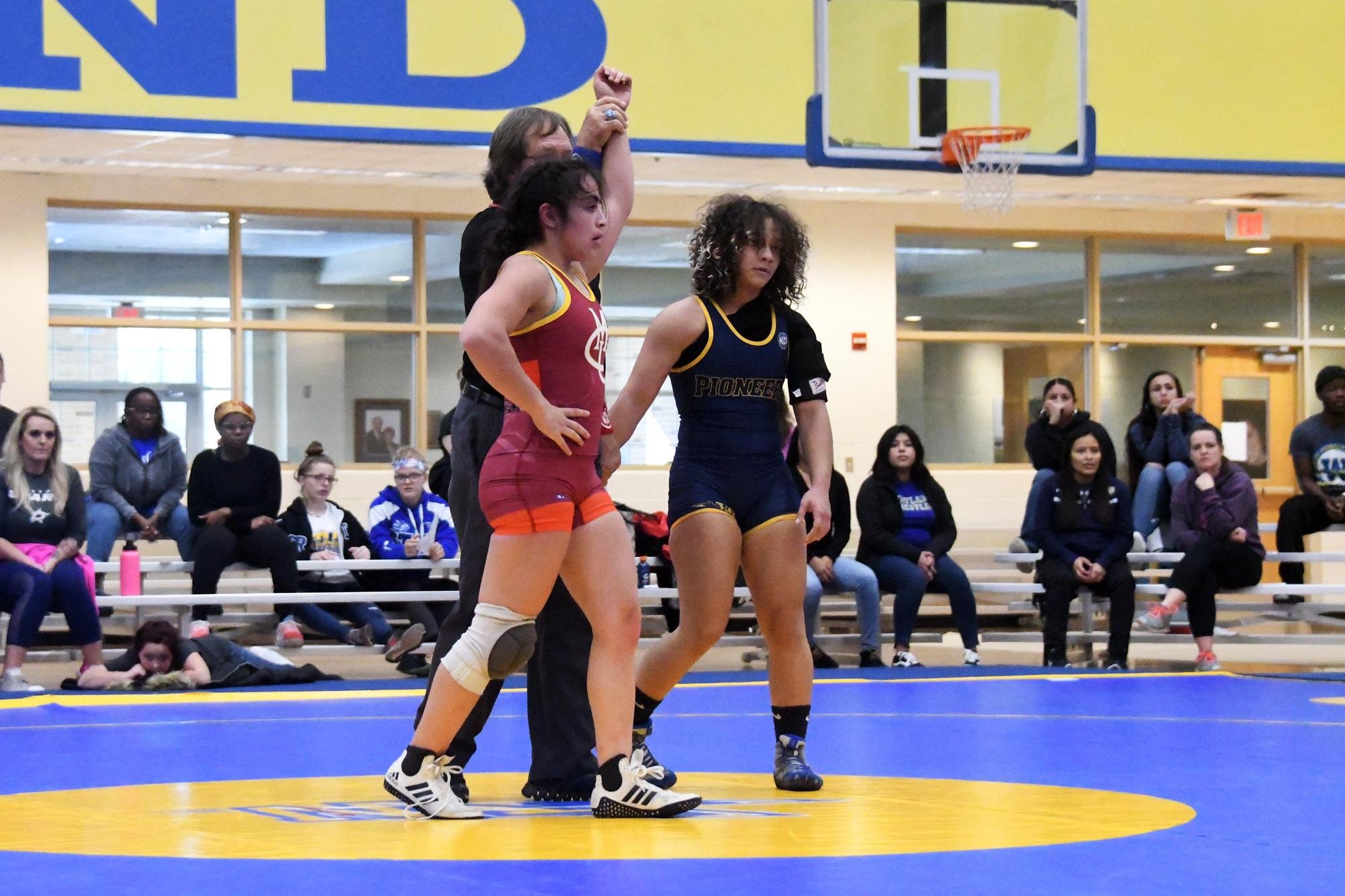Why Redshirt?
Colorado Mesa’s Marissa Gallegos took a redshirt year a few seasons ago. Photo courtesy of Colorado Mesa Athletics
by Derek Levendusky
Twitter: @AWWderek
At one time in college sports history, the redshirt was mandatory in the NCAA. Until 1967, freshmen could not compete in college sports. In 1968, they were allowed to compete in anything except football and basketball, but even those restrictions were lifted in 1972. So much has changed since then, but the redshirt remains an oft-used resource throughout the careers of college athletes.
We see it every year in men’s and women’s college wrestling.
This year you’re seeing top women’s college programs—like McKendree, Augsburg, and Texas Wesleyan to name a few—redshirt some top athletes. At the same time, there’s mystery surrounding some big names when they don’t appear in the starting lineup for a dual or in a tournament. The fact is, this is the time of year when coaches are still in conversation with their athletes, trying to figure out what’s best for their team and their wrestlers.
So why redshirt? What’s the point?
First, let’s explain what it is. The origin of the word comes from the red jersey typically worn by practice players against the regulars or starters. Today the term refers to an athlete taking a year off to preserve a year of eligibility for a future season. NCAA athletes have the option to redshirt for one year during their collegiate career, meaning they can sit out for one season while retaining four years of eligibility. That eligibility must be used, however, within a certain time frame. With NCAA Division I sports, the athlete has a “five-year clock” meaning the four years of eligibility must be used within that five-year span. This can be extended, of course, by adding medical redshirts, Olympic redshirts, or the once-a-century situation that arose last year—Covid “redshirts,” where student-athletes were able to compete without it counting against their eligibility. In NCAA Divisions II and III and the NAIA, athletes have a “10-semester/15-quarter clock” meaning that once the student-athlete “has reached either 10 semester or 15 quarter terms of attendance, the student must cease all participation in all sports” (NAIA.org). This is clock is “flexible” when you add medical redshirts and Olympic years to the equation.
Even with the restrictions redshirt seasons require, in college wrestling many wrestlers still compete “Unattached” in Opens, which means they can get some experience against college competition without losing a year of eligibility. What they cannot do is represent their school in a dual or compete in postseason events that crown All-Americans and national champions.
So why red shirt? Here’s a few common reasons.
Injury
The most common reason an athlete would redshirt is due to injury and injury recovery. There are cases where an athlete can get a medical redshirt and a non-medical redshirt but would need a waiver for the sixth year as normal circumstances require the aforementioned “five-year clock and four seasons of competition” in Division I and the “10-semester/15-quarter rule” in Divisions II, III & in the NAIA. Being given the sixth year is not a given and requires an application process to obtain a waiver.
To receive a medical redshirt, the NCAA has two requirements: First, the injury must have occurred in the first half of the competitive season and second, the wrestler must have participated in less than 30% of the season.
Development
For obvious reasons, the level of competition in college athletics is significantly higher compared to high school sports, and a year of technical and physical development can be immensely helpful for a college wrestler. Practicing for a year against college athletes and receiving higher level coaching can have the “level-up” effect that we often see. That being said, wrestling fans are well aware that there are many freshmen entering the college scene not only ready to contribute, but ready to contend for All-American and national title spots. Augsburg’s Emily Shilson, McKendree’s Cameron Guerin, or Menlo’s Gracie Figueroa are all examples of this, winning national titles as freshmen for their respective programs.
In the 2018-2019 season, then-freshman Marissa Gallegos of Colorado Mesa took a redshirt season and came back the next season as a national contender.
Olympic years
Like we saw the last two years, elite wrestlers will often take an “Olympic redshirt” to focus on their Olympic training and process during an Olympic year. This was especially convoluted these last few years due to Covid as many athletes potentially received two Olympic redshirts.
It’s very strange, but we now have the possibility of having an “8th year senior” because a wrestler could feasibly use a traditional redshirt, gray shirt (when wrestler postpones enrollment until second semester but competing for local club), two Olympic redshirts, and four years of eligibility. Add medical redshirts and the Covid pass and God only knows how long an athlete can stay in a program these days! Crazy times!
Opportunity
Sometimes a wrestler might choose to redshirt if they have limited opportunities in a given year due to the depth at their weight within the college program. You’ll often see this with college quarterbacks or in wrestling with cases where you have multiple national contenders at the same weight. Sometimes an upperclassman will already be established at a certain weight or there’s just too much depth around the weight classes a freshman hopes to compete at. Waiting a year could clear the deck.
As an aside, though the WCWA Nationals, when it was the go-to women’s college nationals, allowed a maximum of 15 entries per program, a coach could choose to put a maximum of three wrestlers at one weight, which happened in 2019 when McKendree entered Alexandria Glaude, Jasmine Bailey, and Joye Levendusky at 155 pounds, resulting in the rare feat of three All-Americans at the same weight from one program. Glaude won it, Bailey took 6th, Levendusky was 7th. That may have happened before, but that’s a pretty unique accomplishment in college wrestling and the more common route would be to redshirt one of them.
This demonstrates the different coaching philosophies with how the redshirt is used, as McKendree coach Sam Schmitz seems to like getting his freshmen right onto the mat and into the thick of college wrestling, while other coaches might like to put the redshirt immediately on some of their freshmen.
Good for the team
Often a wrestler will redshirt because it’s just good for the team. There may be an upperclassman All-American or national title contender at a certain weight and, looking ahead, a coach and younger wrestler will decide to make the team stronger the following season, or even a few seasons later, by sitting a younger elite athlete. You’ll even see this in reverse, where an older wrestler will redshirt and perhaps compete on the USAW circuit for a year while a younger wrestler gets an opportunity to develop sooner than later. It really comes down to what’s good for the team.
Academics
Giving an athlete a year to mature and acclimate to college life may also help them succeed academically, especially of the field of study is particularly challenging. Many athletes rightly put their education at the top of the list and the redshirt can be a very important resource for some students that may be in a particularly challenging phase of their academics. Further, scholarships are often included in a redshirt year so the student could actually get five years of college paid for. This may mean the start of a Master’s Degree program is paid for on the front end. That’s a great advantage for wrestlers aiming at certain careers post-wrestling.
Redshirts can be very helpful throughout the careers of college wrestlers, giving them a chance—and their programs—a chance to optimize and make the most of their college experience.

